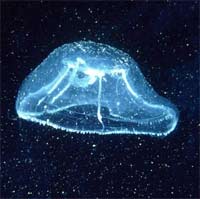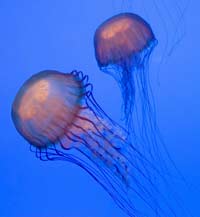
Australian researchers have used ultrasonic tagging to learn that these creatures sleep on the ocean floor between 3pm and dawn. It is believed that they sleep to conserve energy and to avoid predators.
The box jellyfish uses powerful venom contained in epidermic nematocysts to stun or kill its prey prior to ingestion, or as an instrument for defence. Its venom is among the most  deadly in the animal kingdom and has caused at least 63 recorded deaths since 1884; most often, these fatal envenomations are perpetrated by the largest species of box jellyfish, Chironex fleckeri, owing to its high concentration of nematocysts, though at least two deaths in Australia have been attributed to the thumbnail-sized irukandji jellyfish (Carukia barnesi). Those who fall victim to Carukia barnesi suffer several severe symptoms known as Irukandji syndrome. deadly in the animal kingdom and has caused at least 63 recorded deaths since 1884; most often, these fatal envenomations are perpetrated by the largest species of box jellyfish, Chironex fleckeri, owing to its high concentration of nematocysts, though at least two deaths in Australia have been attributed to the thumbnail-sized irukandji jellyfish (Carukia barnesi). Those who fall victim to Carukia barnesi suffer several severe symptoms known as Irukandji syndrome.
Its venom is very distinct from that of Scyphozoa, and is likely an evolutionary tool enabling them to catch their prey (fish and small invertebrates).
In the summer, box jellyfish are abundant in the warm waters of northern Australia and drive away most swimmers; in order to prevent fresh victims, some popular beaches erect enclosures off shore to keep predators out, though smaller species such as Carukia barnesei can still filter through the net.
Some theorize box jellyfish actively hunt their prey—for effective hunting they move extremely quickly (moving at speeds up to 3-3 1/2 knots (1.5 to 1.8 m/s)), and have an active visual system of 24 eyes located on the center of each side of its bell.
The eyes occur in clusters on the four sides of the cube-like body. Sixteen are simply pits of light-sensitive pigment (eight slit-shaped eyes and eight lens-less pit eyes), but one pair in each cluster is surprisingly complex, with a sophisticated lens, retina, iris and cornea, all in an eye only 0.1 millimetres across
The lenses on these eyes have been analyzed and could form distortion free images. Despite the perfection of the lenses, the retinas of the eyes lie closer to the lens than the optimum focal distance resulting in a blurred image. One of these eyes in each set has an iris that contracts in bright light. Four of the eyes can only make out simple light levels.
It is not currently known how this visual information is processed by Cubozoa, as they lack a central nervous system.
Pantyhose were once worn by Australian lifeguards to prevent stings. These have now been replaced by lycra stinger suits.

If swimming at a beach where box jellyfish are known to be present, a bottle of vinegar is an extremely useful addition to the first aid kit. For some as yet unknown reason, acetic acid, found in vinegar, disables the box jellyfish's stinging cells that have not yet shot into the bloodstream (though it will not alleviate the pain). If stung, bathe the affected area with liberal amounts of vinegar and immediately seek medical attention. Vinegar has helped save dozens of lives on Australian beaches. Methylated spirit and alcohol should not be used.
It should be noted that, although commonly recommended in folklore and even some papers on sting treatment, there is no scientific evidence that urine, ammonia, meat tenderizer, sodium bicarbonate, boric acid, lemon juice, or papaya will disable further stinging, and indeed these substances may even hasten the release of venom.
All text is available under the terms
of the GNU Free Documentation License
|

